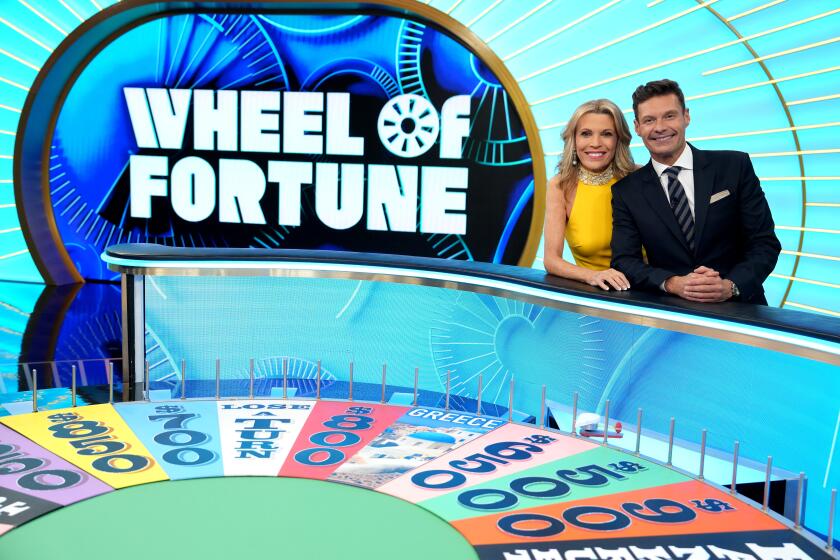Perspective: A fully dimensional look at 3-D and its use in ‘Pina’
3-D or not 3-D: That is the question. Or at least it’s one question ricocheting through the dance community in the aftermath of “Pina,” Wim Wenders’ recent 3-D film tribute to the late innovative German choreographer and Tanztheater Wuppertal company leader Pina Bausch.
In one sense, it’s a nonissue: Every classic dance film ever made would have infinitely more power with real dimensional space around, behind, above and in front of the dancers. Think about Fred Astaire gunning down the corps in “Top Hat” or the fantastic colors and shapes in “The Red Shoes” ballet or Baryshnikov defining male classicism for the whole century in “The Turning Point” or Patrick Swayze having the time of his life in “Dirty Dancing” or the Merce Cunningham company making modernism irresistibly seductive in “Points in Space.” (Add your own favorites to the list.)
But right now 3-D is arguably just a novelty act, existing in so many formats and processes that it’s premature to embrace it as the future of film and video dance. For starters, the stats on “Pina” say it exists in Digital 3-D and Real 3-D (that’s a corporate name, not a value judgment), as well as 2-D. And current 3-D eyewear ranges from those red-and-green plastic glasses you need for most YouTube 3-D on through so-called passive movie specs to expensive electric goggles required for 3-D TV. Most of them darken the image or desaturate color and some impose a flicker or shimmer.
What’s more, “Pina” is a special case, a valedictory compendium of excerpts, not a dance film per se. Indeed, Wenders arguably misrepresents Bausch’s achievements by emphasizing early and pure-dance pieces, never revealing that some of the exquisitely eccentric passages on view are embedded in multidisciplinary three- to four-hour panoramic epics. Bausch’s sense of time in the theater and her use of audience-confrontation tactics are ignored. What remains is eine kleine Pina: her Tanztheater with only the Tanz.
Still, the sight of massed dancers hurling themselves at the camera — at us — in “The Rite of Spring” proves spectacular. And when they kick dust, throw water and blow leaves in your face elsewhere in the film, the footage recalls the retro lion-in-your-lap thrills of “Bwana Devil,” Hollywood’s first color 3-D feature back in 1952.
If such moments exploit 3-D technology in the most obvious manner, the dance photography as a whole nullifies it magnificently. Look at the trailer online in ordinary 2-D and you’ll find dimensional qualities strongly evident in the placement of the cameras, the dancers, the foreground and background objects — the whole look of the shots. You don’t miss anything.
Then watch Astaire and Ginger Rogers in their glorious “Never Gonna Dance” duet near the end of George Stevens’ “Swing Time” from 1936. It’s the same: a perfect dimensional illusion created by the depth and design of the set (including the painted floor), the sustained camera movement, the dancers’ interaction. 3-D can be an enhancement to such collaborative artistry, but it can’t rescue a mediocre director, choreographer or director of photography. With all its limitations, “Pina” is three-for-three on that score, and it’s easy to understand why it received an Oscar nomination for best documentary.
For dance-makers eager to experiment with 3-D, relatively inexpensive camcorders are now available, and some even provide a choice of exhibition formats. (Without a 3-D TV or computer, you’ll need to learn the word “anaglyph” and buy some of those red-and-green glasses.) But just about everyone in the field considers 3-D-with-glasses a clumsy, transitional technology, soon to be as passé as VHS. Yes, 3-D content — from “Avatar” to “Pina” and beyond — will be reproduced in every new mode. But rather than investing in a doomed format, it might be better to wait and watch conversion technology develop.
It’s no secret that some movies released in 3-D weren’t shot that way — they’re digital conversions. And as the sale of 3-D TVs and 3-D Blu-Ray players increase, vault treasures also will be converted for the home-video market. Did you really think that your Blu-Ray “Gone With the Wind” with all those special features was the ultimate collector’s edition? Not a chance. Get ready for Scarlett and Rhett in 3-D. And maybe, eventually, “The Red Shoes” and some of the other dance classics listed above.
Down the line, you can also hope that Adobe Photoshop/Premiere or Final Cut Pro X or some other state-of-the-art home-editing system will create a consumer program that will allow you to convert your home movies to 3-D — and your own dance films as well. So shoot now as if it’s 3-D and wait for the tech wars to deliver formats and processes that won’t get in your way or quickly become obsolete.
The marketplace rules, but the tech-savvy consumer has more prominence than ever in the media world. TV news, for instance, now depends on citizen-videographers being on the scene of major events — a.k.a. personal coverage. And sooner or later, citizen-choreographers working in 3-D, holography or whatever comes after that will transform film and video dance through personal artistry. It won’t matter if the images come from a lowly camcorder rather than fancy studio equipment because it’ll be the essential bedrock experience: dancing with true depth. But first we’ve got to get rid of those glasses.
Formerly The Times’ dance critic, Segal is a freelance arts writer. He’s been shooting in various 3-D formats (prints, slides and now video) since 1983.
More to Read
The biggest entertainment stories
Get our big stories about Hollywood, film, television, music, arts, culture and more right in your inbox as soon as they publish.
You may occasionally receive promotional content from the Los Angeles Times.










